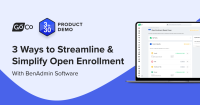Top 5 Open Enrollment Mistakes and How To Avoid Them
A look at the top common open enrollment mistakes and actionable tips to prevent them for a smooth process and happy employees.
by Anna Coucke - August 14th, 2024
Open enrollment season is enough to make even the most relaxed HR and business leaders break out in a cold sweat. Between navigating confusing plan options, dodging compliance nightmares, and keeping a diverse workforce happy, it's easy to see how things can go south faster than you can say "deductible."
Open enrollment mistakes can have significant consequences. For employees, making the wrong choices can lead to unexpected medical bills, inadequate coverage, or lost benefits. For employers, errors can result in compliance issues, increased costs, and decreased employee morale. A well-executed open enrollment process is essential for both parties.
To help you prepare to conquer open enrollment season, we put together this handy guide to identifying and navigating the common pitfalls of open enrollment.
Mistake 1: Poor Communication
Effective communication is the bedrock of a successful open enrollment period. When employees have clear and accurate information about their benefit options, they are more likely to make informed decisions, leading to increased satisfaction and reduced administrative burdens for HR teams.
The Impact of Poor Communication
It’s no secret that poor communication can spell disaster. Here are just a few ways that poor communication can negatively impact your organization:
Employee Confusion: Vague or incomplete information can leave employees feeling overwhelmed and uncertain about their benefits.
Enrollment Errors: Misunderstandings about plan options, costs, or deadlines can result in employees selecting the wrong coverage.
Increased Administrative Burden: A high volume of employee inquiries about benefits can overwhelm HR departments and lead to decreased productivity.
Decreased Employee Satisfaction: Frustration with the enrollment process can negatively impact employee morale and job satisfaction.
Examples of Effective Communication
Benefits options can be confusing, which is why communication and presenting clear information about benefits is so vital. Here are a few examples of how your organization can ensure that employees get the information they need to make informed decisions:
Benefit Comparison Charts: Create visual aids that clearly outline the differences between plan options, including costs, coverage levels, and deductibles.
Enrollment Guides: Develop step-by-step guides to walk employees through the enrollment process.
Interactive Webinars: Host live seminars or webinars with Q&A sessions to address employee questions and concerns.
Benefit Counseling: Offer one-on-one counseling sessions for employees who need personalized assistance.
By investing in clear and effective communication, organizations can create a positive open enrollment experience that empowers employees to make informed decisions and reduces administrative burdens.
Mistake 2: Overlooking Compliance
The healthcare landscape is a constantly shifting maze of regulations. From the Affordable Care Act (ACA) to nondiscrimination laws, employers face a daunting task in ensuring compliance. Overlooking these requirements can lead to hefty penalties, reputational damage, and legal troubles.
The High Cost of Non-Compliance
Failure to comply with healthcare regulations can result in severe financial penalties. The IRS imposes significant fines for violations of ACA reporting requirements, such as the employer shared responsibility payment and the employer reporting requirements. Additionally, the Department of Labor enforces strict rules regarding employee benefits, including retirement plans and COBRA continuation coverage.
Beyond financial penalties, non-compliance can damage an organization's reputation and erode employee trust. News of compliance failures can spread quickly, impacting recruitment, retention, and customer relationships.
Building a Strong Compliance Foundation
With compliance continuously evolving, it is paramount to stay up-to-date with any changes that may affect your organization. Instead of relying on word-of-mouth, be proactive in monitoring compliance within your organization in multiple ways:
Dedicated Compliance Resources: Consider assigning a dedicated compliance officer or team to monitor regulatory changes and ensure adherence to all applicable laws.
Benefits Consultant Partnership: Partnering with a knowledgeable benefits consultant can provide valuable expertise and support in navigating complex compliance requirements.
Regular Compliance Audits: Conduct internal audits to identify potential compliance gaps and implement corrective actions.
Employee Training: Educate employees about their rights and responsibilities under healthcare laws, such as COBRA and HIPAA.
Stay Informed: Subscribe to industry publications, attend conferences, and participate in webinars to stay updated on regulatory changes.
Document Everything: Maintain thorough documentation of compliance efforts, including policies, procedures, and training records.
By prioritizing compliance and building a robust compliance infrastructure, organizations can mitigate risks, protect their employees, and maintain a positive reputation.
Mistake 3: Ignoring Employee Needs
Ignoring employee needs when crafting benefit packages is a surefire way to erode morale and increase turnover as employees seek opportunities with companies that offer benefits more aligned with their needs. By actively seeking and responding to employee preferences in benefits offerings, organizations can create a more engaged and satisfied workforce.
The Importance of Employee-Centric Benefits
Offering employee-centric benefits is not just about meeting their benefits needs; it also shows that your organization truly cares about listening to and understanding them. Providing employee-centric benefits can often lead to:
Increased Employee Satisfaction: When employees feel heard and valued, they are more likely to be satisfied with their jobs and committed to the organization.
Improved Retention: Offering benefits that align with employee needs can help reduce turnover by increasing job satisfaction and loyalty.
Enhanced Productivity: Happy and healthy employees are more productive and engaged, contributing to overall business success.
How to Gather and Act on Employee Feedback
The best way to understand employee benefits needs is to get insight on what is most important to them. Here are just a few ways you can gather employee feedback on benefits:
Conduct Regular Surveys: Implement annual or biannual employee satisfaction surveys to gauge benefit preferences and identify areas for improvement. Consider using a mix of quantitative and qualitative questions to gather comprehensive feedback.
Host Focus Groups: Facilitate small group discussions with employees to delve deeper into their benefit needs and concerns. Focus groups can provide valuable insights into specific employee segments, such as young professionals, parents, or older workers.
Leverage Technology: Utilize employee engagement platforms or HRIS systems to gather real-time feedback through suggestion boxes or pulse surveys. This allows for more agile responses to changing employee needs.
Tailoring Benefits to Employee Demographics
By analyzing employee demographics, organizations can identify specific groups with unique benefit needs. For example:
Young Professionals: May prioritize student loan repayment assistance, mental health support, and flexible work arrangements.
Families: May value family-friendly benefits such as childcare subsidies, dependent coverage, and family leave policies.
Older Workers: May prioritize retirement savings options, health and wellness programs, and long-term care insurance.
By offering a variety of benefits that cater to different life stages and needs, organizations can demonstrate their commitment to employee well-being and create a more inclusive work environment. And they don’t all need to be expensive, either; there are a multitude of budget-friendly benefits options as well!
Remember, the key to successful benefit planning is ongoing communication and collaboration with employees. By actively listening to their needs and preferences, organizations can create benefit packages that drive employee satisfaction and business success.
Mistake 4: Ignoring Data
Ignoring enrollment data is a missed opportunity to gain valuable insights that can drive informed decision-making and improve your overall benefits strategy. By harnessing the power of data, organizations can optimize benefit packages, control costs, and enhance employee satisfaction.
The Importance of Data Analysis
Analyzing data may not sound exciting, but it’s an opportunity to see exactly what is driving employee satisfaction (or dissatisfaction) when it comes to benefits. You may even uncover opportunities to improve your benefits package and even save a bit of money! Here are just a few of the things that collecting and analyzing benefits data can uncover:
Identifying Trends: Analyzing enrollment patterns over time can reveal emerging trends in employee preferences and needs. For example, an increasing interest in mental health benefits or a growing number of employees with dependents might indicate opportunities to expand coverage.
Measuring Benefit Utilization: Tracking how employees utilize their benefits provides valuable information about plan effectiveness. By identifying underutilized benefits, organizations can explore ways to increase awareness or make adjustments to plan offerings.
Assessing Plan Performance: Comparing plan costs to utilization rates can help determine the cost-effectiveness of different options. This information can be used to negotiate better rates with carriers or explore alternative plans.
Predicting Future Costs: By analyzing historical claims data, organizations can identify potential cost drivers and develop strategies to mitigate risk. For example, if claims for a particular condition are increasing, employers can implement wellness programs or preventive care initiatives to address the issue.
How to Leverage Data
Gathering benefits data is undoubtedly important, but how do you go about doing it? Here’s how you can gather and leverage data to make the best decision for your organization and employees.
Data Collection: Implement a robust data collection system to capture enrollment information, claims data, and employee demographics. Consider using HRIS or benefits administration software to streamline this process.
Data Analysis: Use data analysis tools to extract meaningful insights from the collected data. Look for patterns, trends, and correlations that can inform decision-making.
Data-Driven Decision Making: Incorporate data-driven insights into the benefit planning process. Use the information to refine benefit offerings, set budgets, and develop communication strategies.
Continuous Improvement: Data analysis is an ongoing process. Regularly review and update your data to ensure that your benefit strategy remains aligned with employee needs and market trends.
Mistake 5: Procrastination
Procrastinating on open enrollment planning is akin to waiting until the last minute to pack for a vacation. It's a recipe for stress, errors, and potential disaster. By delaying the planning process, HR teams set themselves up for rushed decisions, increased workloads, and a higher likelihood of overlooking critical details.
The Cost of Procrastination
Procrastination doesn’t just affect HR; it can have wide-reaching consequences that can reverberate throughout the company. Here are just a few of the consequences of procrastination:
Increased Stress Levels: Last-minute scrambling to meet deadlines can lead to burnout and decreased job satisfaction among HR professionals.
Errors and Omissions: Rushing through the open enrollment process increases the chances of mistakes in enrollment data, benefit selections, and compliance paperwork.
Poor Communication: When time is tight, it's difficult to effectively communicate complex benefit information to employees. This can lead to confusion, frustration, and incorrect enrollment decisions.
Decreased Employee Satisfaction: A chaotic open enrollment process can negatively impact employee morale and satisfaction, potentially leading to higher turnover rates.
The Benefits of Early Planning
So, how can you avoid a last-minute open enrollment disaster? It’s probably no surprise that creating a plan ahead of time can help you avoid this pitfall. Early planning provides HR and leadership ample time to research benefit options, analyze costs, and gather employee feedback in order to make the best decisions about benefits offers.
It also allows time to develop a comprehensive communication plan, ensuring employees have the information they need to make the right benefits decisions for themselves and their dependents.
Creating a Detailed Open Enrollment Timeline
A well-structured timeline is essential for having a successful open enrollment and avoiding the stress that comes with procrastination. Here's a basic outline to get you started:
6-8 months before open enrollment: Begin initial planning, form an open enrollment task force, and conduct employee needs assessments.
4-6 months before open enrollment: Research and select benefit options, develop communication materials, and create an enrollment platform.
2-4 months before open enrollment: Conduct employee benefit education sessions, finalize enrollment materials, and test enrollment systems.
1-2 months before open enrollment: Launch communication campaigns, provide employee support, and address enrollment questions.
Post-enrollment: Conduct enrollment audits, analyze data, and prepare for the next open enrollment period.
By assigning specific responsibilities to team members and setting clear deadlines, you can ensure that everyone stays on track and contributes to the overall success of the open enrollment process.
Final Thoughts
By avoiding these common mistakes, you can transform open enrollment from a stressful ordeal into a strategic opportunity to enhance employee satisfaction and optimize your benefits package. Remember, the open enrollment process is more than just a yearly administrative task; it’s an investment in your employees’ well-being and your company’s overall success.
Ready to see how you can take the next step towards simplified benefits administration in your organization? With an HRIS like GoCo, employers can easily manage benefits administration and all of your benefits in one place, including health, dental, vision, life, accident and disability, HSA, FSA, HRA, commuter benefits, and more.
GoCo equips employees with convenient and comprehensive self-service enrollment, which allows them to view plans at a glance, easily understand coverage, and enroll in minutes. Benefits are also kept in sync with your payroll and insurance carriers within GoCo, which makes the management process easier. Peace of mind comes as a standard as well with ACA compliance and hassle-free solutions. Want to see for yourself how simple benefit administration (and much more) can be with GoCo? Learn more about our automated benefits administration software and take a free tour of our platform today!
Ready to explore GoCo?
Check out our interactive Product Tour.
Take a Tour →Please fill your info to start experiencing GoCo
FAQs
-
Clear and accurate communication helps employees understand their benefit options, reduces errors, and improves employee satisfaction.
-
Some ways to stay compliant include staying updated on healthcare regulations, assigning a compliance officer, partnering with a benefits consultant, conducting regular audits, using HR software, and subscribing to industry publications.
-
You can gather employee feedback through surveys and focus groups, offer a variety of benefits to meet different needs, and communicate effectively.
-
You can analyze enrollment data to identify trends, measure benefit utilization, assess plan performance, and predict future costs.
Recommended Posts
20 Strategies to Support Employee Mental Health
Blog Articles
Search...
Product
GoCo
Resources
Articles
eBooks
Webinars
Customer Stories








